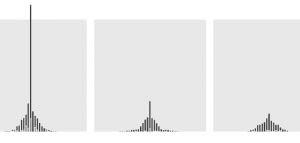Despite what some believe, email continues to be a dominating way to communicate with others and to use in your digital marketing campaign.
Email marketing is a quick, easy and effective form to get your content directly in front of an intended audience.
Plus, the audience of email marketing campaigns are already leads, so you just need to figure out a way to reel them in.
In order for your email marketing to be successful, you must be familiar with the click-to-open rate (CTOR), how to calculate it, and even ways in which you can improve it. Otherwise, your campaign could fall flat.
Let’s dig in, shall we?
What is CTOR?
The click-to-open rate is designed to measure the percentage of how many people clicked on a link within an email after opening it.
It is the number of clicks divided by the number of opens. This type of metric is essentially measuring how effective the content in your email is.
CTOR vs. CTR vs. Open Rate: What’s the Difference?
The open rate for your email informs you of the number of recipients who opened your email.
It does not take into account the amount of time they spent viewing the email or whether they clicked on a link within the message.
For instance, if your email was sent out to 2,500 people, you may be informed that 1,200 people opened the email. This represents a 48% percent open rate, which is incredibly strong when it comes to email marketing.
The click-through rate for your email will inform you of the number of clicks that the email received after being opened by the recipient.
This metric lets you see how many people opened and viewed your email. Unfortunately, it doesn’t measure who clicked on the links within.
While both of these metrics are important for your email marketing campaign, as they help to identify whether you created relevant and engaging subject lines/headlines, they don’t show you the bigger picture.
This is where CTOR comes in, as this metric helps you determine whether the email content is garnering the attention you desire.
Why is Tracking Your CTOR Important?
CTOR is important simply due to the fact that this metric can show you whether an email recipient found the content in your email relevant and effective.
For instance, a high click-to-open rate tends to indicate that customers find your email content, layout, images, links, etc. valuable and informational.
A low click-to-open rate tends to indicate the opposite — that your content is not incredibly relevant or engaging.
So, basically, the longer an individual stays on your email, peruses the content within, and finally clicks through, the higher you can expect your CTOR to be.
A CTOR allows you to assess the quality of the email content, identify insights into your customers regarding what they like and what they deem as pertinent, and reduce your overall cost of lead generation.
How to Calculate a CTOR
Now that you understand what CTOR is and why it is important to your business, it’s time to learn how to calculate your own click-to-open rate.
It’s incredibly simple.
All you need to do is divide the number of unique clicks by the number of unique opens. Once you have this number, multiply it by 100. This provides you with the CTOR percentage.
CTOR: unique clicks/unique opens x 100
As far as unique clicks go, you may be confused as to what this means. This is simple, too.
A unique click is defined as the number of email clicks by recipients divided by the number of overall emails sent.
A unique open rate is then defined as the number of unique email opens divided by the overall number of emails sent.
Unique refers to only one recipient opening the email or clicking on the link once. If the same person goes back and opens/clicks a second time, this would not be unique.
You must only count the initial open or click; otherwise, you may find inaccuracies within your campaign data.
Therefore, it is imperative to only count unique opens and clicks to ensure that your data is as accurate as possible.
Quick example
Let’s say that you send an email out to 1,500 people. Let’s also say that 250 people open the email, and there are a total of 175 clicks.
To find the CTOR for this email campaign, you would calculate it as follows:
175/250 x 100 = 70%
This is a very high click-to-open rate, and it indicates that the bulk majority of the people who opened the email clicked on the link within the content.
Ideally, you should strive for somewhere between 20 and 30 percent (or more, of course!). This number will vary depending on your audience and industry.
Higher CTOR is often seen in certain industries like real estate, the media, education, agriculture, and government.
Lower CTOR (although still good) tends to be seen in industries like food, retail, and travel.
What is the Average Click-To-Open Rate?
Overall, the average click-to-open rate among all industries is 14.1 percent.
This average number should ideally be used as a benchmark in your own email marketing campaign.
If you can beat this average CTOR, then you are doing something right. Of course, this doesn’t mean you can strive to make improvements that will garner a higher CTOR in the future.
However, if your own CTOR is below the average, there is some room for improvement in your campaign. By changing things up, you are likely to see considerable gains.
How to Increase Your CTOR
Regardless of what your exact goal is (raising brand awareness, generating leads, or even increasing sales), you need to figure out how to get clicks from your emails.
This will make your email marketing campaign as cost-effective as possible.
In order to increase your click-to-open rate, your focus must be on the content in the emails you are sending. It is this content that will encourage recipients to click on your link.
Here are a few things you can do to improve your CTOR.
1. Create More Scannable Emails
Everyone leads busy lives, regardless of what this may look like from one person to the next. Therefore, people don’t have a ton of time to spend reading their emails.
To aid readers who are in a hurry, it is important to ensure your emails are short and sweet and scannable.
This gets the information across to your reader quickly while also making it easy for them to grasp the key points of the email.
With that being said, you will want to ensure the most important information is at the start of the email and use images and links as supplemental material.
2. Personalize the Content
Readers like to feel valued, and this can be done by taking a more personalized approach to the content.
Dynamic content tools can help make this process easier.
For instance, these tools can help address each reader by the name they provided at sign-up or identify products that would be best suited to each reader’s individual purchasing habits.
Ultimately, the more personalized the email is to the reader, the more likely the reader will click the links within.
This is because the reader believes you took the time to personalize that email for them, which shows in a higher CTOR.
3. Create Engaging and Relevant Subject Lines
The subject line is an important part of your overall email, as it is what will grab the attention of readers and help them decide whether to open the email or send it to the trash folder without even reviewing the content inside.
The subject line needs to have a certain “wow” factor to it, but it also needs to represent the content within the email well.
Otherwise, when readers open the email and start browsing the content, they will realize that the subject line was only clickbait and close out of the email without clicking on the internal links.
When your subject lines are on point with the email content, it is far more likely the email will be read and readers will interact with the links. In the end, this all helps improve your click-to-open rate.
Remember this: while it is important to get that email opened, it is just as important, if not more so, to obtain that conversion. Relevant and engaging subject links can help make this happen.
4. Utilize CTA Buttons
When your email consists of a lot of text, even text that’s broken up into smaller, scannable sections, it can be much more enticing to see a CTA button as opposed to a text-based click-to-action.
While text-based CTAs are effective, data shows that CTA buttons can actually have a more positive effect on clickthrough rates.
If you decide to opt for a CTA button, you will want to ensure it is placed at the end of the offer.
Further, it should be kept short and sweet (no more than three or four words), and it should contain action words.
5. Review your results
To keep your email marketing campaign on track, you want to be frequently looking over your results and analyzing what your data tells you.
And yes, keeping track of your CTOR is definitely essential, but remember — so is comparing it with other metrics to gain valuable insight about your campaign.
For example, let’s say your data reveals a high open rate but also a CTOR that leaves a lot to be desired.
That might suggest that your subject lines are absolutely fantastic, but the actual content of your emails isn’t as compelling as it could be.
Or maybe your CTOR is great, but your conversion rate is poor. Then you might want to work on making your offers more compelling.
Experiment with different approaches. Track your results and use what they tell you to keep improving your campaigns.
6. Use high-quality images
Beautiful, high-quality images can be just as powerful when you include them in your email correspondence as they are on social media and within your web content.
Images are an effective way to immediately stir your readers’ emotions and nudge them toward the impression you want them to have of your brand.
They’re also an excellent way to help the rest of your content really come alive on a level that practically begs a reader to click through and learn more.
Always make sure your images are not only high in quality but properly sized to fit your email content. Otherwise, you risk them throwing the layout of your email out of whack.
They should make sense within the context of your content, as well.
Funny, smart, compelling, or stunning — anything goes when it comes to images, as long as it supports the rest of your message, so don’t be afraid to get creative.
Bonus: Should You Rely on CTOR Alone?
Modern consumers are increasingly protective of their privacy when it comes to their personal data, and tech companies are listening.
As a result, we’re seeing advances like Apple’s Mail Privacy Protection, which prevents a sender from viewing certain data regarding how a user interacts with a sent email, including whether it was opened in the first place.
If you can’t reliably know whether a recipient opened their email, then you can’t (and shouldn’t) rely on CTOR alone to assess the success of your outreach content.
Keeping track of metrics like the following, as well, can help you keep things accurate.
Clickthrough Rate
Naturally, this is the total number of people who actually click on any links you include within your email. In any instance where a recipient was interested enough in your content to click, you can reasonably call that email successful.
Email Conversion Rate
This metric reflects the percentage of email recipients who not only clicked through but followed up by completing a specified call to action suggested by your email content.
This could mean downloading a free ebook you offered, viewing video content, adding your brand on social media, and so forth.
Unsubscribe Rate
This is the percentage of people who eventually decide they’re no longer interested in receiving further emails from you and unsubscribe from your mailing list altogether.
This metric can help you zero in on things that may not be working about your messages.
Bounce Rate
This metric refers to the number of sent emails that never even make it to your recipients’ inboxes in the first place.
Try to keep your email bounce rate under 2 percent. If it’s consistently much higher than that, it could be time to clean up your email list, send your messages via a more respectable service, or improve the overall quality of your email outreach.
Wrap Up
Whether you want to increase brand awareness, build on customer relationships, or increase email interactivity, improving your CTOR is essential.
The click-to-open rate helps to identify the engagement level of the content within your emails. By knowing this rate, you can begin to optimize your content based on the needs and wants of your customers.
To increase the chances of your email marketing campaign working to your advantage, you should embark on the journey of creating an email funnel.
Learn more about email funnel marketing here.


![[ROCK NA] [EBOOK SEO] Complete Guide](https://rockcontent.com/wp-content/uploads/2024/06/banner_Search-Engine-Optimization.png)






